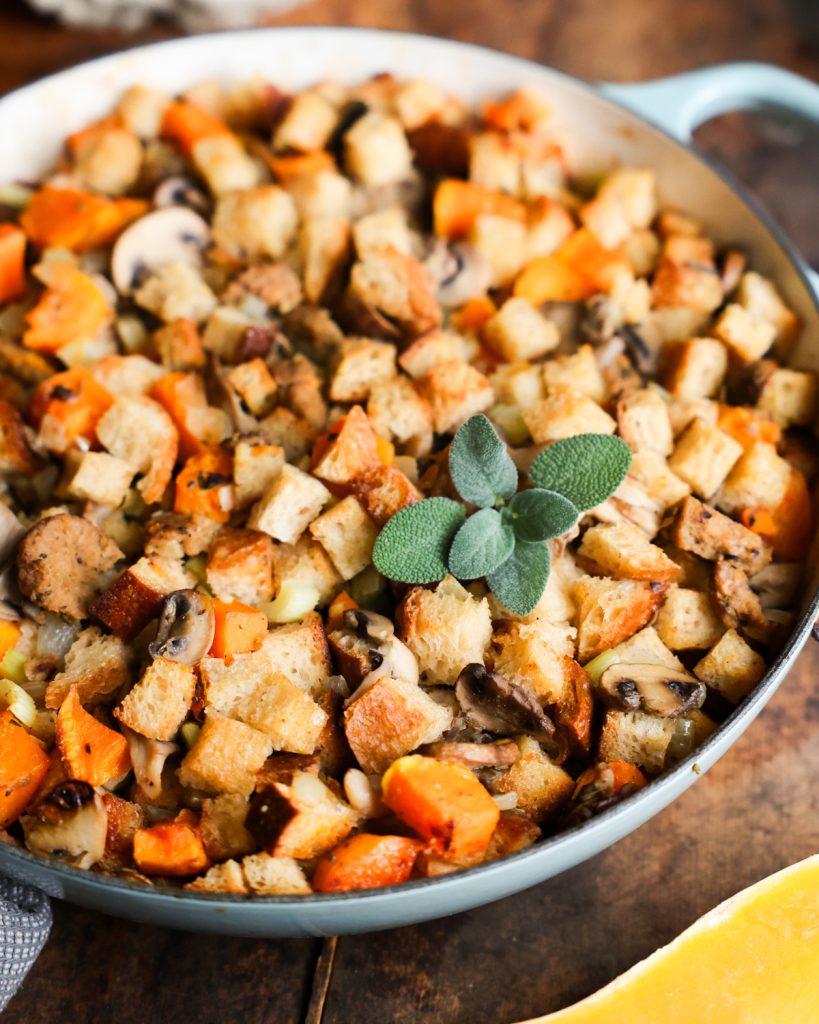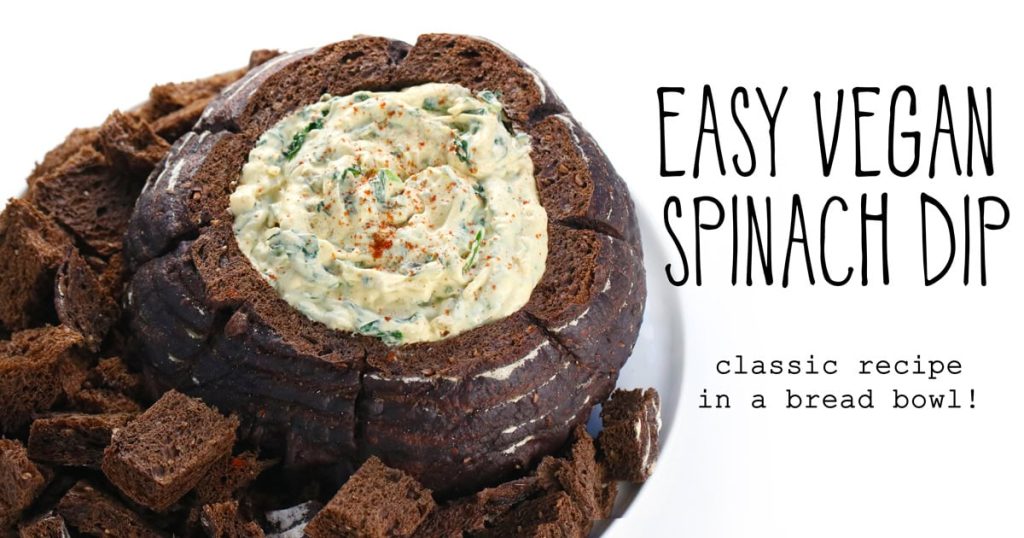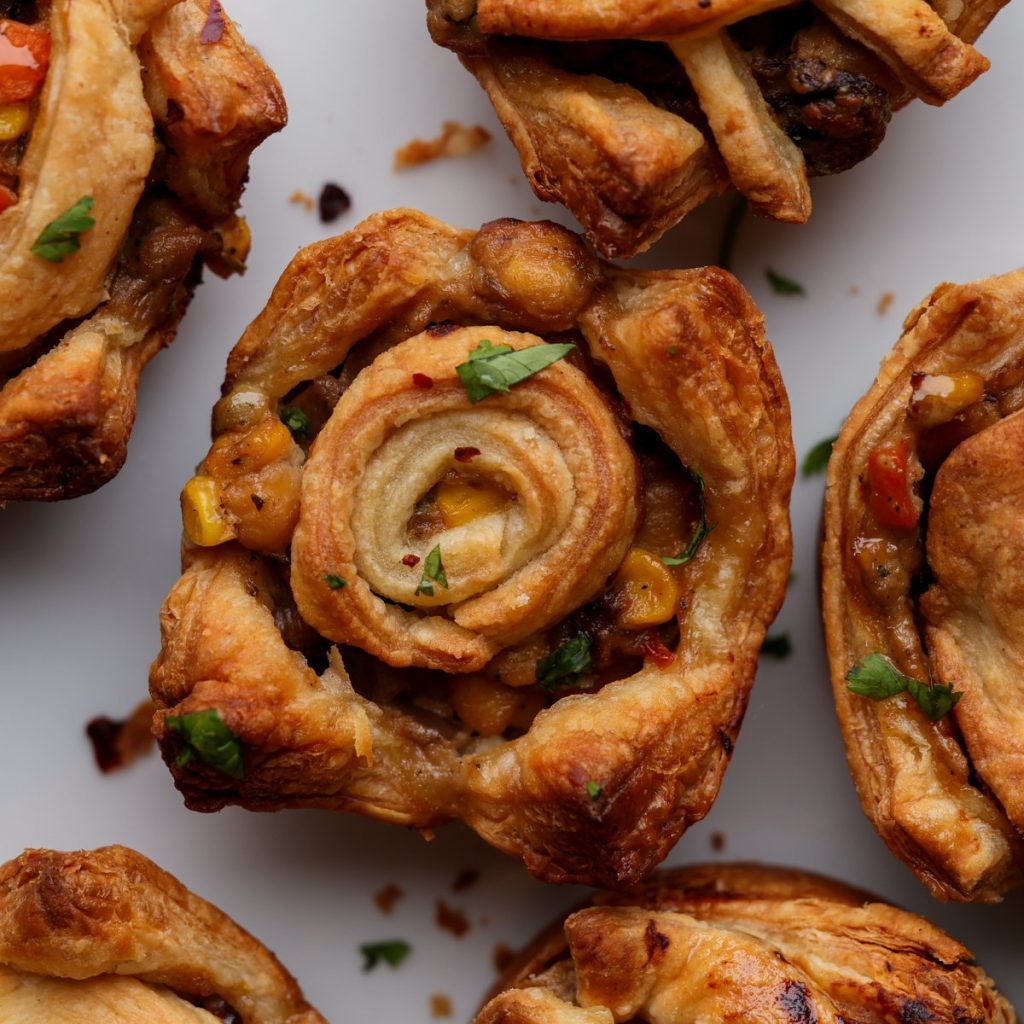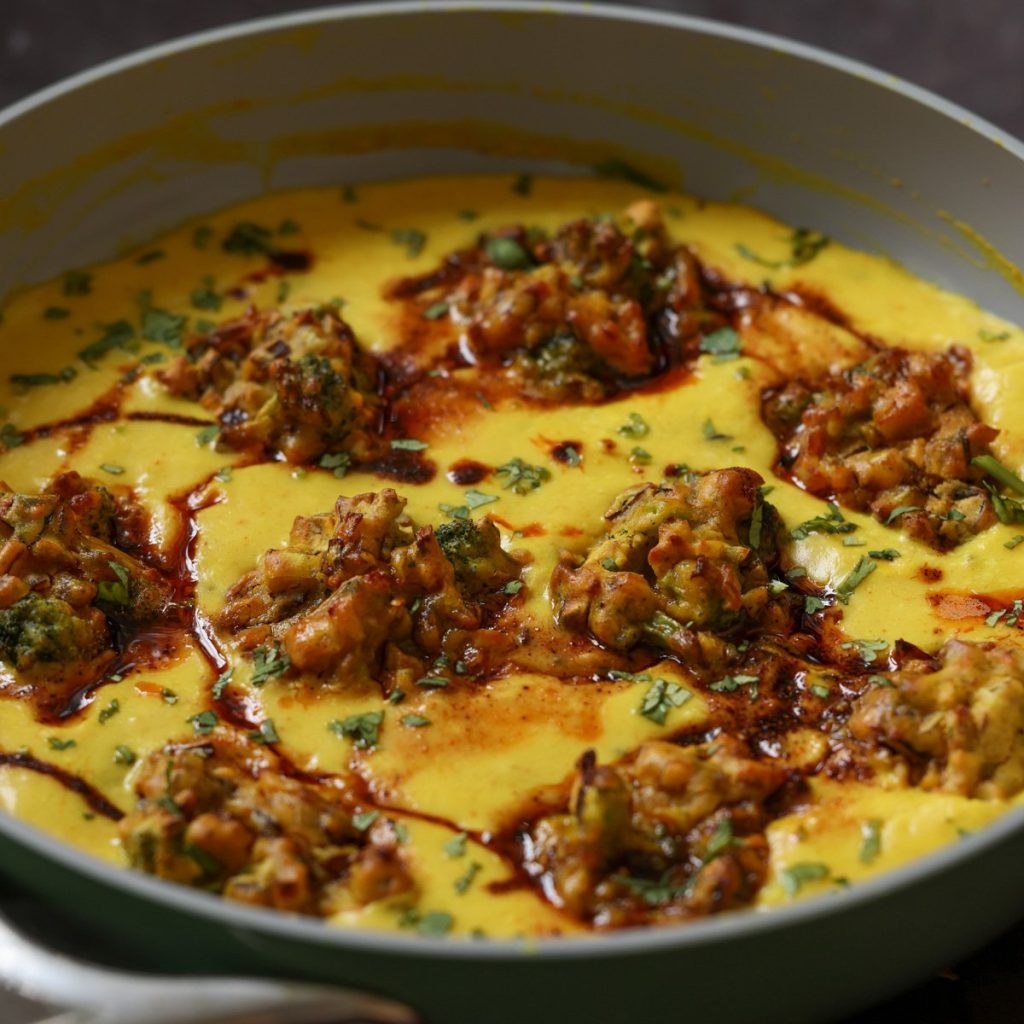
Kadhi pakora is a popular, homestyle North Indian curry starring crispy vegetable pakora fritters in a creamy yogurt curry sauce. This version is from North Indian Punjabi cuisine (gluten-free, soy-free, nut-free). Orginally published may 15, 2013. Updated with photos video and details.
In Indian cuisine, kadhi is a spiced, saucy dish, often made with yogurt. The creamy sauce can be paired with fritters, veggies, papadums based on region and often served over rice. Spices and texture vary by region as well.

Punjabi kadhi (North Indian kadhi from the state of punjab), like this kadhi pakora, is usually creamier and made with sour yogurt, while Maharashtrian kadhi(from maharashtra state) is thinner with spiced oil d featuring mustard seeds and curry leaves, and Gujarati kadhi is sweeter and can often have other spices, as well. Marwari kadhi tends to be hotter, with more chilies, and has variations like papad kadhi where crisped papadums are added to the kadhi right before serving, which makes for a great texture combination.

For today’s kadhi, we are using cumin seed tarka, and for the fritters we’re using chickpea flour, which is the flour of white chickpeas or garbanzo beans. That is different from besan, which is the flour of brown chickpeas. There is a difference between besan and chickpea flour. If you’re using besan, you will need much less water to make the batter for the fritters.
The baked fritters when soaked in the kadhi, are more like dumplings. Delicious on their own and also with the sauce.
You can also make your own Coconut Milk Yogurt or Peanut yogurt or Cashew yogurt or use store bought for the Kadhi.

Why You’ll Love Kadhi Pakora
- crispy broccoli-onion fritters in a creamy curry sauce
- make the sauce while the fritters bake in the oven
- super rich and creamy curry sauce from non-dairy yogurt and chickpea flour
- naturally gluten-free, soy-free, and nut-free
More North Indian Curries
For the Tarka or Spiced oil/Tempering
For the Optional Chili Oil
Prevent your screen from going dark
Make the fritters.
-
Preheat the oven to 410° F (210° C).
-
Add the chickpea flour, rice flour, spices, and baking powder to a bowl, and mix really well. Then mix in the non-dairy yogurt and 3 tablespoons of water. If you need more water, add in a tablespoon of water at a time to make a really thick batter. You want the batter to be thick, because the veggies will leak some moisture while baking. Once you have the batter ready, add in the onion and broccoli, tossing well to coat. Then, drizzle the oil, and lightly toss again.
-
Scoop this mixture onto a parchment-lined baking sheet, using either cookie scoops or a large spoon. You want to heap them tall, and not make flat fritters. Bake for 20 minutes or until the fritters are golden and crisp on top. You can also broil them for a minute in the end to make them a little more golden. Remove the baking sheet from the oven, and let the fritters cool for a few minutes
Meanwhile, make the kadhi (curry).
-
In a bowl, mix the yogurt, chickpea flour, turmeric, salt, cayenne, and 1/4 cup of the water. Use a whisk to mix really well, so that the chickpea flour mixes in. Then, mix in the remaining 3/4 cup of water, and set aside.
Make the tempering.
-
Heat a saucepan or skillet over medium heat, and add the oil. Once the oil is hot, add in the cumin seeds and mix for a few seconds, then add in the fenugreek seeds and mix again. Cook until the cumin seeds change color significantly, then add in the dried chilies, and mix for a few seconds. Reduce the heat to medium-low, add in the garlic and the ginger, and mix and cook, stirring frequently, so that they don’t burn.
-
Once the garlic is golden, add in your yogurt mixture and increase the heat to medium again. Mix really well, and bring to a boil. Once it is boiling it will start thickening. Continue to cook for another 5 minutes, then add more water to adjust the consistency to preference. Depending on the yogurt you use, this might get really thick. I usually add 1/2-1 cup more of water for a slightly thinner curry. Bring back to a boil, then taste and adjust salt and flavor. Add more salt if needed. If you want more tang, mix in some lemon juice or some chaat masala. Simmer for another 2 minutes, and switch off the heat.
Serve the kadhi.
-
Place the fritters on top of the curry, and then make the optional chili oil. If you prefer crispier fritters, you can serve the curry with the fritters on the side, and let people top them with the curry at the table or eat the curry over rice with fritters on the side, if they prefer.
-
Chili oil: Heat the oil in a small skillet over medium-low heat. Once the oil is hot, switch off the heat. Mix in the cayenne, then quickly drizzle this all over the fritters and the curry and serve topped with fresh cilantro. If you are keeping the fritters on the side, only drizzle the chili oil and sprinkle the cilantro on the curry.
To make ahead, you can make the kadhi sauce beforehand and keep it in the fridge for up to 3 days. Ideally, make the fritters right before serving, so that they stay crisp. If you do need to pre-make the fritters, you can air fry them or put them in the oven again to crisp back up before serving.
You can also fry the fritters, if you prefer. Instead of baking, just fry until golden.
I use chickpea flour in this recipe. To use besan, use 2 tablespoons of water in the fritters, and add more only if needed to make a thick batter. In the curry, use a tablespoon more of besan, so a total of 4 tablespoons (1/4 cup) of besan instead of 3 tablespoons of chickpea flour.
Calories: 198kcal, Carbohydrates: 23g, Protein: 9g, Fat: 9g, Saturated Fat: 1g, Polyunsaturated Fat: 2g, Monounsaturated Fat: 4g, Sodium: 464mg, Potassium: 289mg, Fiber: 3g, Sugar: 6g, Vitamin A: 235IU, Vitamin C: 10mg, Calcium: 125mg, Iron: 1mg
Nutrition information is automatically calculated, so should only be used as an approximation.

Ingredients and Substitutions
- chickpea flour – This is the base for the fritters and and also used to thicken the kadhi sauce. Recipe notes include directions for using besan instead, as the amount of flour and moisture you need will be different.
- rice flour – Helps the fritters get so crispy!
- ground spices – For the fritters, you will need turmeric and garam masala. The yogurt curry sauce uses more turmeric and some cayenne. You’ll also use cayenne to make the optional chili oil topping.
- non-dairy yogurt – Adds moisture to the fritters and adds moisture and creaminess to the curry sauce.
- broccoli and onion – These are your fritter veggies!
- oil – Adds moisture to the fritters and is used to sauté.
- whole spices – The tarka uses cumin seeds and fenugreek seeds.
- aromatics – For the tarka/tempering, you also add dried chilis, minced garlic, and minced ginger.
💡 Tips
- Get the fritters into the oven first, so you can make the curry sauce while they bake.
- When roasting the whole spices, stir frequently so they don’t burn.
- You want the batter for the fritters to be very thick, because the liquid from the broccoli and onion will thin it as it bakes.
How to Make Punjabi Kadhi Pakora
First, make the fritters. Preheat the oven to 410° F (210° C).
Add the chickpea flour, rice flour, spices, and baking powder to a bowl, and mix really well. Then mix in the non-dairy yogurt and 3 tablespoons of water. If you need more water, add in a tablespoon of water at a time to make a really thick batter. You want the batter to be thick, because the veggies are to leak some moisture while baking.
Once you have the batter ready, add in the onion and broccoli, tossing well to coat. Then, drizzle on the oil, and lightly toss again.
Scoop this mixture onto a parchment-lined baking sheet, using either cookie scoops or a large spoon. You want to heap them tall, and not make flat fritters.
Bake for 20 minutes or until the fritters are golden and crisp on top. You can also broil them for a minute in the end to make them a little more golden. Remove the baking sheet from the oven, and let the fritters cool a bit.

Meanwhile, make the curry.
In a bowl, mix the yogurt, chickpea flour, turmeric, salt, cayenne, and 1/4 cup of the water. Use a whisk to mix really well, so that the chickpea flour mixes in. Then, mix in the remaining 3/4 cup of water, and set aside.
Heat a saucepan or skillet over medium heat, and add the oil. Once the oil is hot, add in the cumin seeds and mix for a few seconds, then add in the fenugreek seeds and mix again.
Cook until the cumin seeds change color significantly, then add in the dried chilies, and mix for a few seconds. Reduce the heat to medium-low, add in the garlic and the ginger, and mix and cook, stirring frequently, so that they don’t burn. Add asafetida if using.
Once the garlic is golden, add in your yogurt mixture and increase the heat to medium again. Mix really well, and bring to a boil. Once it is boiling it will start thickening. Continue to cook for another 5 minutes, then add more water to adjust the consistency to preference.
Depending on the yogurt you use, this might get really thick. I usually add about a cup of water for a slightly thinner curry.
Bring back to a boil, then taste and adjust salt and flavor. Add more salt if needed. If you want more tang, mix in some lemon juice or chaat masala. Simmer for another 2 minutes, and switch off the heat.
Place the fritters on top of the kadhi, and then make the optional chili oil. If you prefer crispier fritters, you can serve the curry with the fritters on the side, and let people top them with the curry at the table or eat the kadhi over rice with fritters on the side, if they prefer.
Heat the oil in a small skillet over medium-low heat. Once the oil is hot, switch off the heat. Mix in the cayenne, then quickly drizzle this all over the fritters and the curry and serve topped with fresh cilantro. If you are keeping the fritters on the side, only drizzle the chili oil and sprinkle the cilantro on the curry.
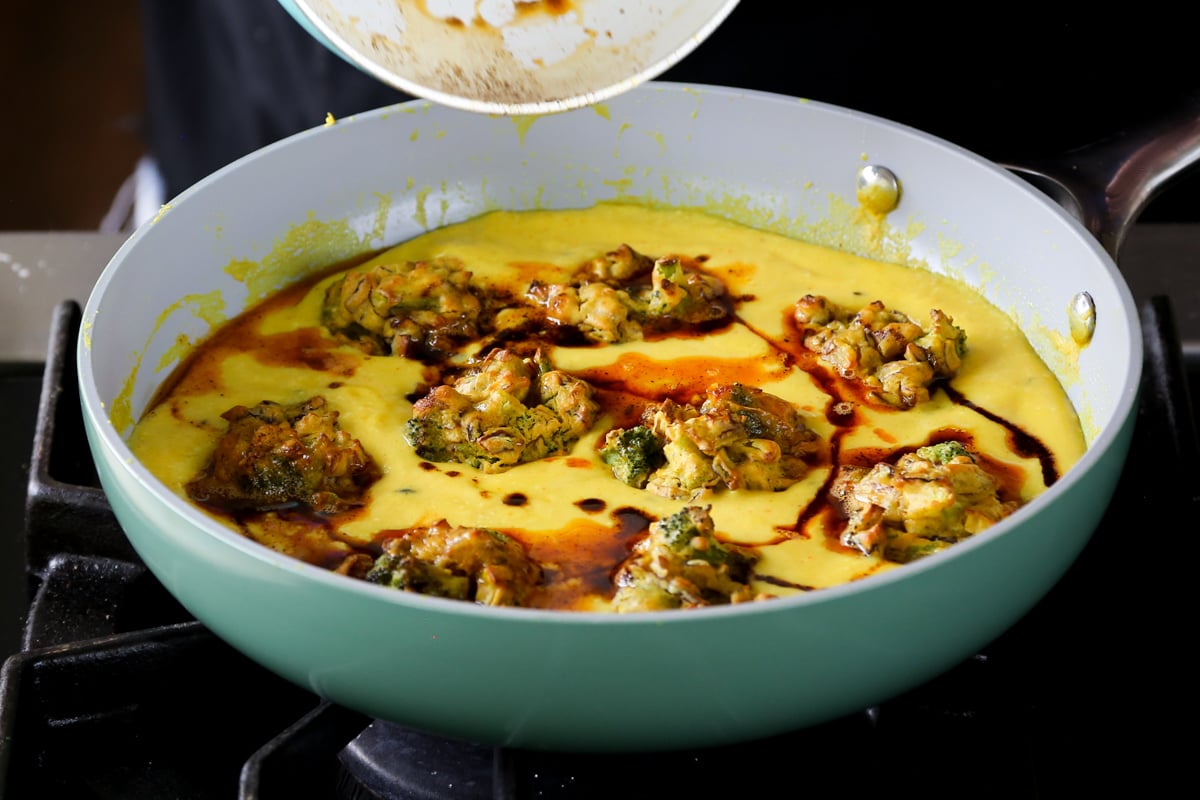
What to Serve with Kadhi Pakora
This can be served on its own with naan or flatbread. Alternatively, you can spoon the curry over rice with the pakora on the side.

Frequently Asked Questions
This recipe is naturally gluten-free. It’s soy-free and nut-free, as long as you use soy-free and/or nut-free non-dairy yogurt.
